In SEO, any advantage to stand out from the competition is welcome. One way to make your website more visual and attractive in Google search results is by implementing structured data.
Thanks to them, users will have more information about what they will find on your website, and the search engine will also be able to better understand how your content is structured.
Do you want to implement these structured data on your WordPress website? Today, you’re going to learn how to do it like a pro.
What Structured Data Is
Structured data is a standardized format that allows providing additional and specific information to users on the Google results page.
They use a vocabulary known as Schema and are usually implemented on your website through JSON-LD code.
They present a clear and consistent structure, enabling search engines to interpret and process the information more effectively.

Why Structured Data Is Important for SEO
The benefits of applying structured data to your website go beyond contributing to SEO improvement. By implementing them, you’ll notice that:
- Increases your page’s visibility: by appearing as a more enhanced result, it will stand out more against other websites on the Google results page.
- Boosts the click-through rate (CTR): these enriched search results are more eye-catching and provide additional information on the search results page, which conveys greater trust to the user and encourages clicks.
- Improves Google’s understanding of your website: Structured data allows search engines to better understand the context of web pages, clarifying any ambiguous terms.
You can achieve these benefits regardless of your business sector, as there is a wide variety of structured data.
Later in the article, you will see examples of the most common structured data, but first, how about I tell you how to implement them on your WordPress site in 4 simple steps?
How to Implement Structured Data in WordPress
- Download and activate a tag insertion plugin
- Access the plugin settings
- Insert the code snippet
- Validate the structured data
One of the safest and easiest ways to implement your structured data is to use a plugin that allows you to insert scripts into the <head> of your site without the need to edit theme files.
I recommend using the free plugin Header Footer Code Manager due to its ease of use.
However, most similar plugins work in a similar way, so this tutorial can also be useful if you opt for other alternatives.
Step 1: Download and activate a tag insertion plugin.
You can download the Header Footer Code Manager, as I have suggested, or look for other alternatives such as Code Snippets or WPCode, although the latter has paid features.
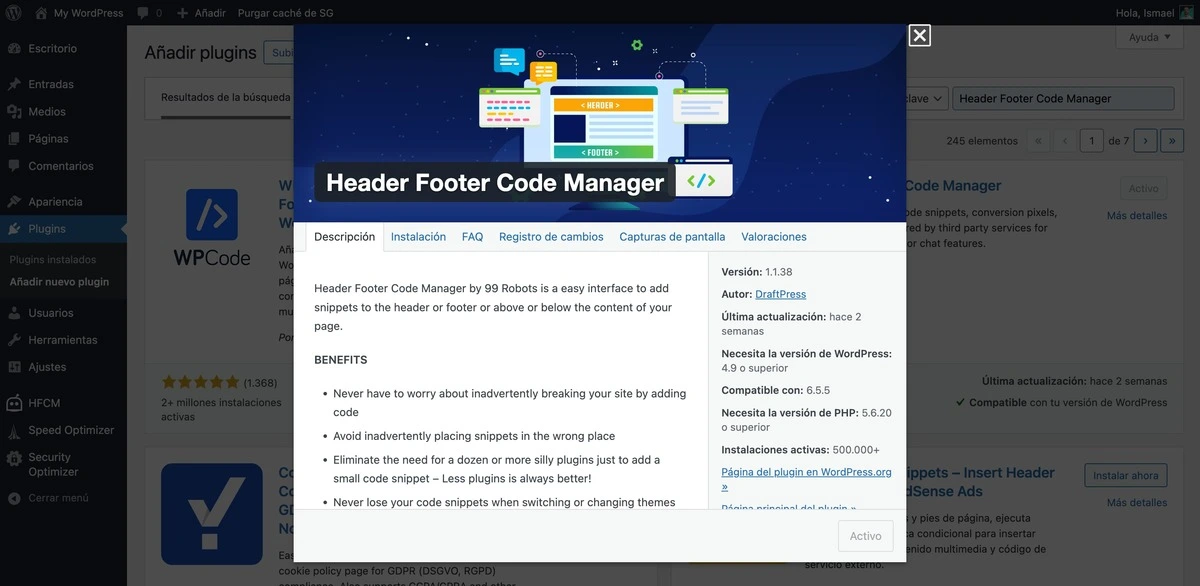
Step 2: Access the plugin settings
To do this, go to the WordPress navigation panel, navigate to “HFCM” in the sidebar, and select “Add New“:

Once there, you should fill in the fields as follows:
- Script Name: For example, “Article Structured Data“.
- Snippet Type: Select JavaScript from the dropdown menu.
- Site Display: Select Specific Posts, or specific pages if it’s structured data for pages. You also have the option to apply it to all posts or all pages.
- Post (Page) List: If you selected to apply the structured data to specific pages or posts, select them here.
- Location: Select Header.
- Device Display: Select All Devices.
- Status: Make sure it is set to Active.
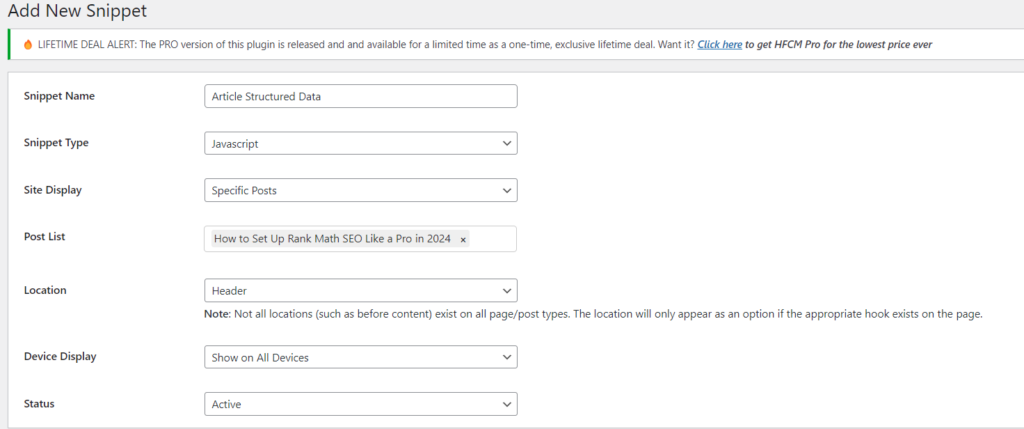
Step 3: Insert the code snippet
Once the code snippet is configured, all that’s left is to insert it.
To do this, scroll down and go to the section “Snippet / Code“. There you can paste the JSON-LD code you generated with ChatGPT to enhance the presence of structured data.
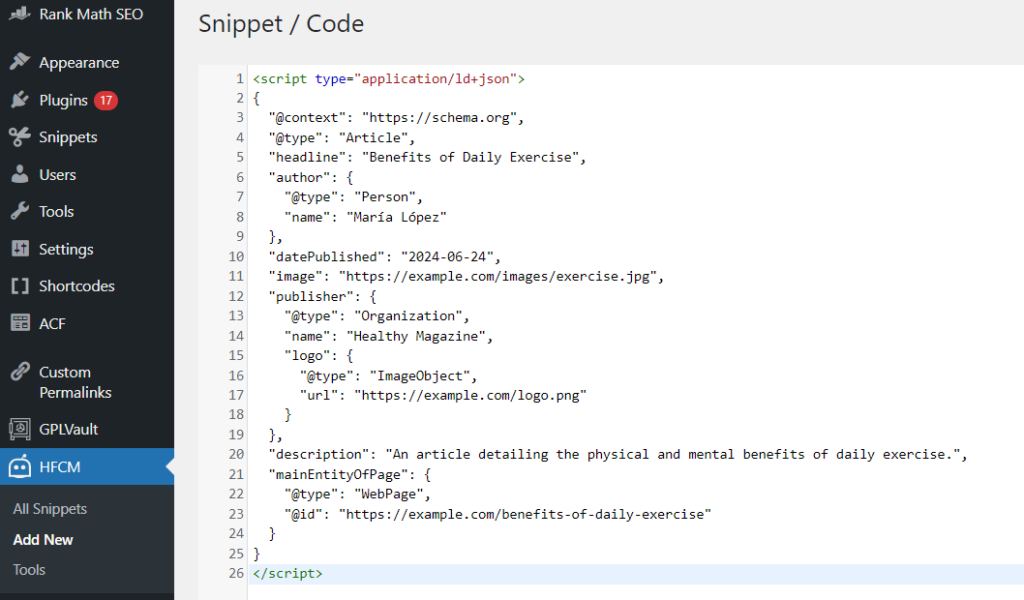
After this, make sure everything is correct and click save.
Step 4: Validate the structured data
Before finishing, I recommend checking if the structured data has been implemented correctly.
To do this, you can go for free to Google’s Rich Results Test and enter the URL of the page or post where you inserted the code snippet.
If everything went well, it should look something like this once you analyze the URL:
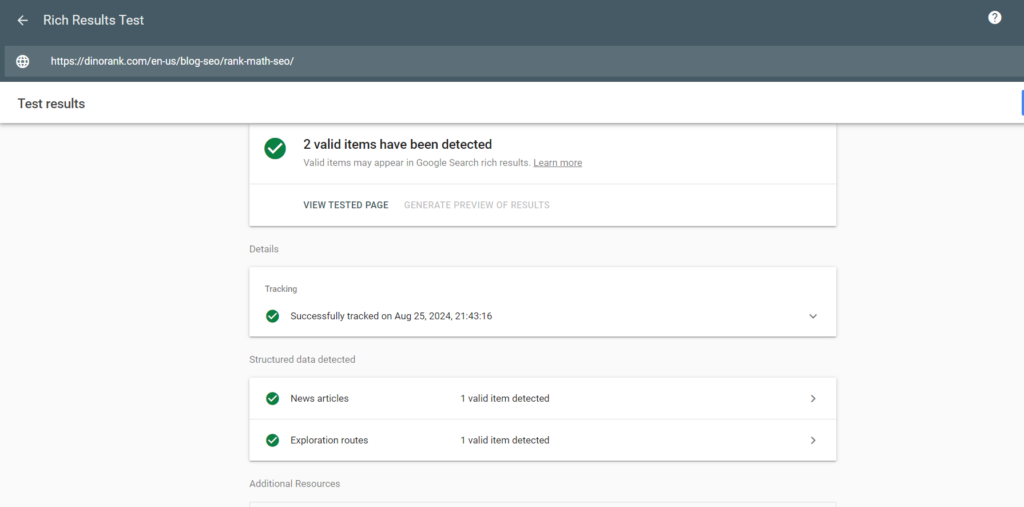
As you can see, it detects a valid element, in this case a “news article“, which is the one I’ve inserted in this example.
If you don’t see something similar, it might be due to a configuration error in the snippet or the code itself, so it’s advisable to review it again.
Below are several examples of the most common and useful structured data for SEO.
How to Generate Different Types of Structured Data
To give you an idea of the variety of structured data that exist, Schema.org has over 800 types of entities and specific objects in its vocabulary.
If you don’t have knowledge of JSON-LD code, you can generate it with the help of the free version of ChatGPT.
Here’s how:
1. Articles
Article structured data is used to mark editorial content, such as news and blogs.
In this case, the most common classes would be:
Article: For general editorial content.NewsArticle: For news.BlogPosting: For blog posts.Report: For reports.HowTo: If your article has step-by-step instructions, this class will help those steps appear in the search results.
For example, here’s how a search with the Article class would look like:

Example of How to Generate Article Structured Data with ChatGPT
If your content is an article, you can ask ChatGPT with the following prompt, replacing the values with those of your specific article:
Prompt Generate a JSON-LD code for structured data of an article titled “Benefits of Daily Exercise”. The details are as follows: – Author: Maria Lopez – Publication Date: 2024-06-24 – Image: https://example.com/images/exercise.jpg – Description: An article detailing the physical and mental benefits of daily exercise. – Published by: Healthy Magazine
The AI will respond with the JSON-LD formatted code for you to simply integrate into your web page:
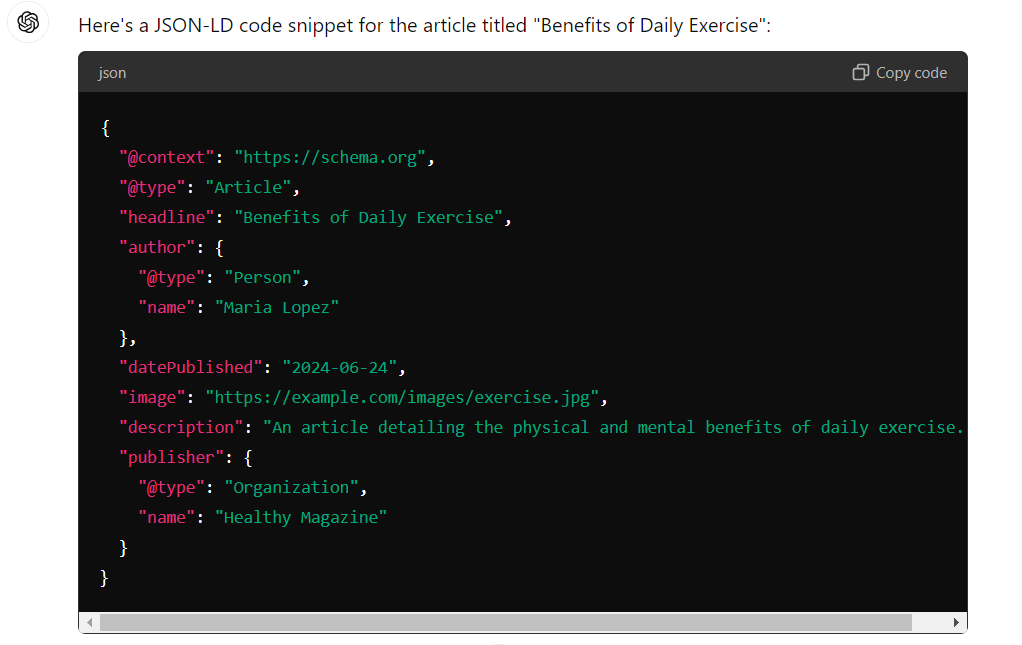
Here is the generated code. Copy it and replace the sample values with those of your article:
<script type=”application/ld+json”> { “@context”: “https://schema.org”, “@type”: “Article”, “headline”: “Benefits of Daily Exercise”, “author”: { “@type”: “Person”, “name”: “Maria Lopez” }, “datePublished”: “2024-06-24”, “image”: “https://example.com/images/exercise.jpg”, “publisher”: { “@type”: “Organization”, “name”: “Healthy Magazine”, “logo”: { “@type”: “ImageObject”, “url”: “https://example.com/logo.png” } }, “description”: “An article detailing the physical and mental benefits of daily exercise.” } </script>
Another positive aspect of this method is that ChatGPT will include the classes that fit your article, so you can get different structured data and rich results.
2. Products
For products, structured data is used to provide information about them, such as their price or availability.
The most commonly used product class is:
Product: For general products.
If you search for “iPhone 15 Pro” on Google, you’ll see several results with a structure similar to this:

This case is a clear example of a good application of product Schema markup.
Keep in mind that if you use WooCommerce, this command is likely added automatically.
Example of Product Structured Data Generated with ChatGPT
If you need to create product structured data, you can use this prompt, replacing it with your product page data:
Prompt Generate a JSON-LD code for structured data for a product called “Espresso Coffee Maker”. The details are as follows: – Description: High-quality espresso coffee maker with multiple functions and elegant design. – Image: https://example.com/images/coffeemaker.jpg – SKU: 12345 – Brand: ExampleBrand – Price: 199.99 USD – Availability: InStock – Rating: 4.5 out of 5 based on 24 reviews.
And its code would be, in this case: <script type=”application/ld+json”> { “@context”: “https://schema.org”, “@type”: “Product”, “name”: “Espresso Coffee Maker”, “image”: “https://example.com/images/coffeemaker.jpg”, “description”: “High-quality espresso coffee maker with multiple functions and elegant design.”, “sku”: “12345”, “brand”: { “@type”: “Brand”, “name”: “ExampleBrand” }, “offers”: { “@type”: “Offer”, “priceCurrency”: “USD”, “price”: “199.99”, “availability”: “https://schema.org/InStock” }, “aggregateRating”: { “@type”: “AggregateRating”, “ratingValue”: “4.5”, “reviewCount”: “24” } } </script>
3. Events
If you want to include details about an event, such as its date, location, and description, you can use event structured data.
Depending on the type of event, you can apply different classes:
Event: For general events.BusinessEvent: For business events.ChildrensEvent: For children’s events.ComedyEvent: For comedy events.CourseInstance: For courses.DanceEvent: For dance events.EducationEvent: For educational events.ExhibitionEvent: For exhibitions.Festival: For festivals.FoodEvent: For food events.LiteraryEvent: For literary events.MusicEvent: For music events.SaleEvent: For sales events.SocialEvent: For social events.SportsEvent: For sports events.TheaterEvent: For theater events.
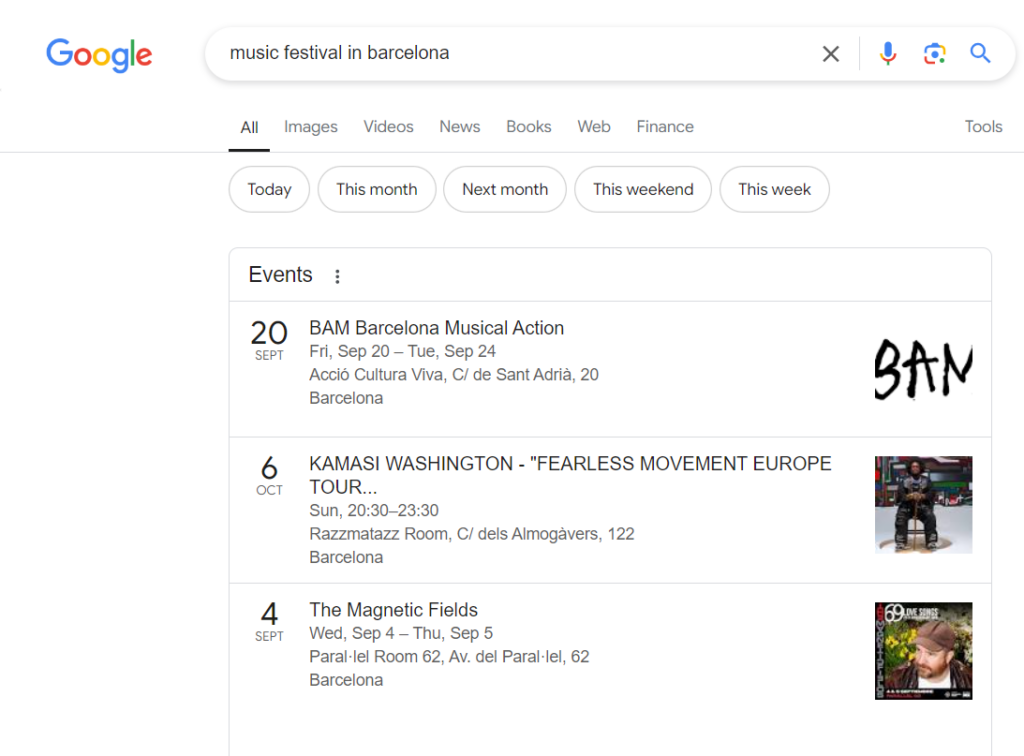
An example of event structured data is a Google search for “music festival in Barcelona”:
In this case, it’s likely that these URLs achieved the rich result thanks to the correct implementation of the MusicEvent structured data, allowing Google to better understand the page’s context.
Use this ChatGPT prompt example to generate event structured data:
Prompt Generate a JSON-LD code for structured data for an event called “Rock Concert”. The details are as follows: – Date: December 1, 2024, 7:30 PM – Location: National Stadium, 123 Fake Street, Example City – Description: A rock concert featuring the best local bands. – Image: https://example.com/images/concert.jpg – Price: 50.00 USD – Availability: InStock
The code returned by the AI is as follows: <div itemscope itemtype=”https://schema.org/Event”> <h1 itemprop=”name”>Rock Concert</h1> <p>Date: <time itemprop=”startDate” datetime=”2024-12-01T19:30″>December 1, 2024, 7:30 PM</time></p> <p itemprop=”location” itemscope itemtype=”https://schema.org/Place”> Location: <span itemprop=”name”>National Stadium</span> <span itemprop=”address” itemscope itemtype=”https://schema.org/PostalAddress”> <span itemprop=”streetAddress”>123 Fake Street</span> <span itemprop=”addressLocality”>Example City</span> <span itemprop=”addressRegion”>Example State</span> <span itemprop=”postalCode”>12345</span> <span itemprop=”addressCountry”>US</span> </span> </p> </div>
4. Recipes
This markup is used to detail ingredients, preparation times, and more for any type of food recipe.
In this case, the most commonly used classes are:
Recipe: To describe a cooking recipe. Provides search engines with detailed information about the recipe, such as ingredients, preparation time, cooking time, instructions, etc.HowToStep: Used to describe each individual step in the recipe preparation process.HowToSection: Groups several steps of a recipe into logical sections, such as washing, cutting, cooking…NutritionInformation: Provides nutritional details about the recipe, such as calories, fats, proteins, etc.
An example of correct application of recipe structured data are the following pages:
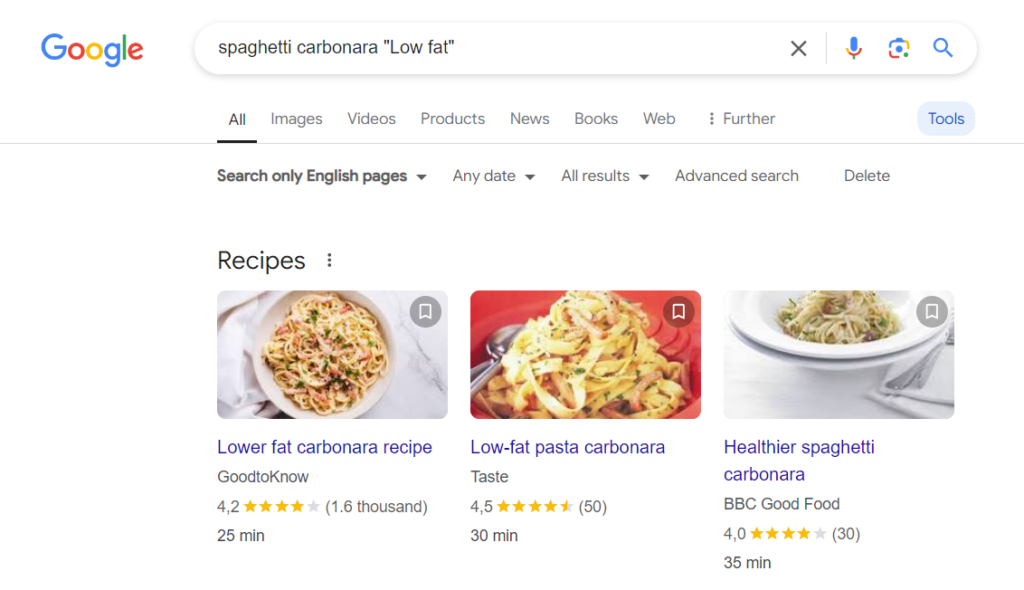
The SEOs of these 3 pages have successfully implemented the Recipe and NutritionInformation classes.
Thanks to this, Google was able to understand that their content is about “spaghetti carbonara” recipes and that they are also low in fat.
Example of Recipe or Recipe Structured Data
If you want to achieve something similar with your content, you can write this message to ChatGPT specifying your business data:
Prompt Generate a JSON-LD code for structured data for a recipe called “Paella”. The details are as follows: – Description: Step-by-step guide to making a delicious paella. – Ingredients: 2 cups of rice, 500g of seafood, 1 whole chicken. – Steps: 1. Prepare the ingredients. 2. Cook the seafood and chicken. 3. Add the rice and broth. 4. Simmer. 5. Serve and enjoy. – Preparation time: 20 minutes. – Cooking time: 40 minutes. – Calories: 500 kcal per serving.
Whose code you can copy and paste, replacing it with your data, is this:
<script type=”application/ld+json”> { “@context”: “https://schema.org”, “@type”: “HowTo”, “name”: “How to Make Paella”, “description”: “Step-by-step guide to making a delicious paella.”, “step”: [ { “@type”: “HowToStep”, “name”: “Step 1: Prepare the Ingredients”, “text”: “Gather all the necessary ingredients: rice, seafood, chicken, saffron, etc.” }, { “@type”: “HowToStep”, “name”: “Step 2: Cook the Seafood and Chicken”, “text”: “In a paella pan, cook the seafood and chicken until golden brown.” }, { “@type”: “HowToStep”, “name”: “Step 3: Add the Rice and Broth”, “text”: “Add the rice and broth, and let it simmer.” }, { “@type”: “HowToStep”, “name”: “Step 4: Simmer”, “text”: “Simmer for 20 minutes until the rice is tender.” }, { “@type”: “HowToStep”, “name”: “Step 5: Serve and Enjoy”, “text”: “Serve the paella hot and enjoy.” } ] } </script>
5. Reviews
If you want to display user opinions about specific content on your website in search results, you can use review structured data.
The most common are:
Review: Used to describe an evaluation or comment about a product, service, or entity.AggregateRating: Used to provide an average rating based on multiple reviews.Person: Used to describe the author of the review, which adds credibility, especially for improving EEAT.Organization: If an organization publishes the review, this class allows you to indicate it to search engines.
To show you what can be achieved with the correct application of structured review data, here is the following example:

This is an example of how structured data for Reviews would look
To display reviews of some content in search results, you can use this ChatGPT prompt and apply it to your website:
Prompt Generate a JSON-LD code for structured data of a review of a product called “Espresso Coffee Maker”. The details are as follows: – Author: John Doe – Rating: 4 out of 5 stars – Review text: The coffee maker is excellent, makes delicious coffee, and is very easy to use. – Published by: Tech Magazine
The respective code would be this: <script type=”application/ld+json”> { “@context”: “https://schema.org”, “@type”: “Review”, “name”: “Espresso Coffee Maker Review”, “reviewRating”: { “@type”: “Rating”, “ratingValue”: “4”, “bestRating”: “5” }, “author”: { “@type”: “Person”, “name”: “John Doe” }, “reviewBody”: “The coffee maker is excellent, makes delicious coffee, and is very easy to use.”, “publisher”: { “@type”: “Organization”, “name”: “Tech Magazine” } } </script>
6. Frequently Asked Questions
If you address any frequently asked questions in your content, including this type of structured data will help increase your visibility and click-through rate. Additionally, you can be more effective in voice searches.
The most common classes of structured data are:
FAQPage: Used to define a page that contains a list of frequently asked questions. This informs search engines that the page is structured as a series of questions and answers.Question: Used to mark each individual question within the FAQ page. This allows search engines to understand what specific question is being answered.Answer: Used to mark the corresponding answer to a specific question. This helps search engines correctly match questions with their answers in search results.
By applying these different Schema markup types, you will have the chance to appear in the frequently asked questions section of search results, as shown here:
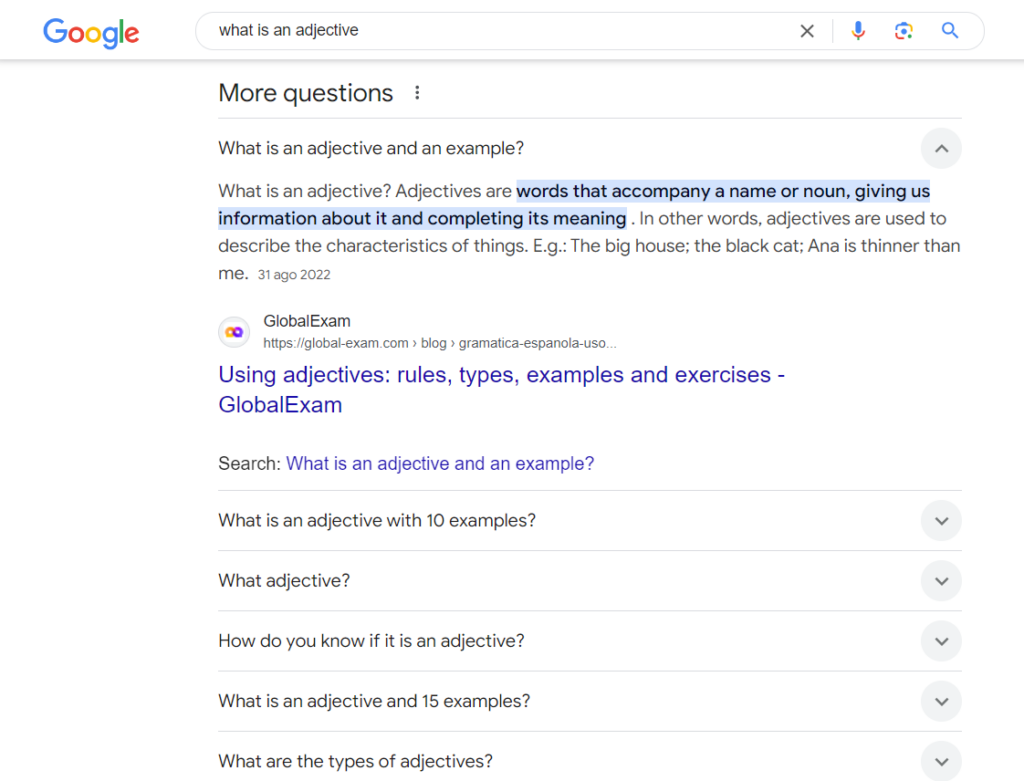
To generate the necessary code to display the FAQs of your website, you can ask ChatGPT with this prompt:
Prompt Generate a JSON-LD code for structured FAQ data about Example Coffee Shop. The questions and answers are as follows: 1. What are the opening hours of Example Coffee Shop? Answer: We are open Monday to Saturday from 8:00 AM to 10:00 PM. 2. Where is Example Coffee Shop located? Answer: We are located at 123 Fake Street, Example City. 3. Do you offer vegan options on your menu? Answer: Yes, we offer several vegan options on our menu, including salads, soups, and desserts.
Once you have determined the JSON-LD code for the various structured data of your website, you just need to implement it on your WordPress site so that search engines can use it optimally.
Now you’re a PRO! Start implementing structured data in your project!
After reading this article and following the relevant steps, you will be able to implement structured data in WordPress like a professional, for free and without needing coding knowledge.
Thanks to its correct implementation, you will be able to differentiate yourself from your competition and significantly improve your website’s SEO ranking.
Try it on the pages of your site that you think could benefit from structured data and let me know how it goes 🙂

